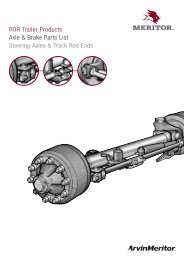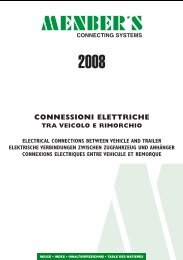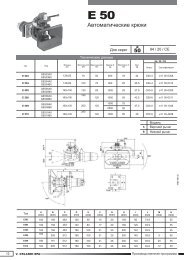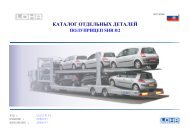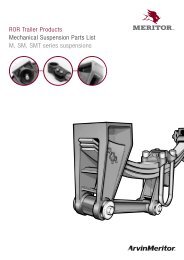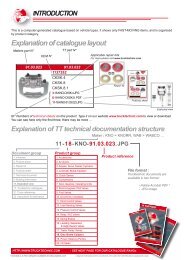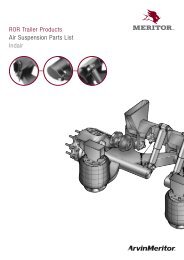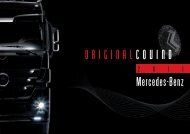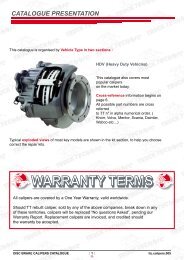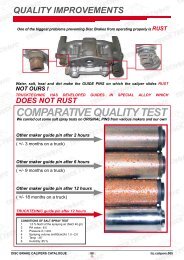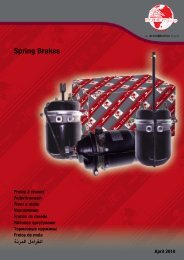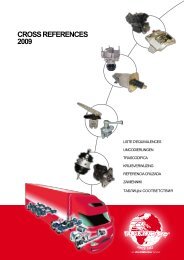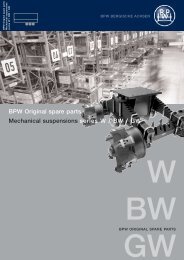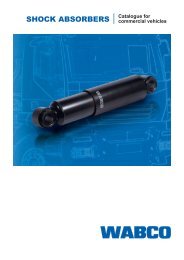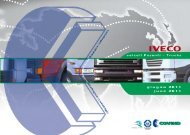You also want an ePaper? Increase the reach of your titles
YUMPU automatically turns print PDFs into web optimized ePapers that Google loves.
Brake Lining Faults<br />
Uneven lining surface<br />
8 12<br />
Main Reasons:<br />
• Wrongly adjusted or worn<br />
axle bearings<br />
Possible Consequences:<br />
• Very high lining and drum wear<br />
• Squeal<br />
Dirt on the lining surface<br />
Main Reasons:<br />
• Dirt particles in the brake<br />
• Poor brake maintenance<br />
(insufficient cleaning)<br />
Possible Consequences:<br />
• High lining and drum wear<br />
• Poor deceleration<br />
• Vehicle pull and excessive brake<br />
noise may occur<br />
9<br />
Cracks around rivet holes<br />
Main Reasons:<br />
• Too heavy riveting force<br />
• Wrong shape of rivet heads<br />
• Brake shoe radius does not<br />
conform to lining radius<br />
• Brake shoe platform is not<br />
clean or even<br />
Possible Consequences:<br />
• Lining and drum breakage<br />
• Brake over-heating<br />
• Noise<br />
13<br />
Build up of dirt between<br />
lining and brake shoe<br />
Main Reasons:<br />
• Shoe radius out of line<br />
• Shoe platform not blast cleaned and<br />
painted properly<br />
• Shoe platform not parallel<br />
• Lining riveted incorrectly<br />
Possible Consequences:<br />
• Cracks in the lining material or crack<br />
in drum surface<br />
• Loose linings<br />
• Squeal<br />
• Improper cleaning causes rust scale<br />
to build up and lift the lining from the<br />
shoe<br />
10<br />
11<br />
Greasy lining surface<br />
Surface crazing<br />
Main Reasons:<br />
• Broken or improperly mounted hub<br />
oil seals<br />
• Excessive lubrication of the bearings<br />
of the braking mechanism<br />
Possible Consequences:<br />
• Vehicle pull may occur if the<br />
problem is only found at one side of<br />
the axle<br />
• Low deceleration<br />
Main Reasons:<br />
• Caused by excessive brake<br />
temperature, i.e. when brake is cold<br />
on motorway then having to perform<br />
a sudden stop i.e. off a slip road.<br />
Rapid temperature input does not<br />
allow for heat soak from<br />
material into brake system<br />
Possible Consequences:<br />
• This condition has no effect on the<br />
integrity or performance of the lining<br />
• Penetration of the crazing is usually<br />
no more than 1mm deep<br />
• Wear through with normal brake<br />
use and has no effect on the lining<br />
14<br />
15<br />
Large fractures in lining surface<br />
Main Reasons:<br />
• Faults in brake mechanism<br />
• Sticking brake shoes (weak return<br />
springs)<br />
• Excessive use of brakes at high<br />
speed<br />
• Overloaded vehicle<br />
• Too large air chambers<br />
Burnt lining surface<br />
Possible Consequences:<br />
• High lining wear<br />
• Vehicle pull and excessive brake noise<br />
• Disintegration of lining<br />
• Low deceleration<br />
Main Reasons:<br />
• Faults in brake mechanism<br />
• Sticking brake shoes (weak<br />
return springs)<br />
• Excessive use of brakes from<br />
high speed<br />
• Wrong brake cylinders/air chambers<br />
or levers<br />
• Overloaded vehicle<br />
• Incorrect brake proportioning<br />
between tractor/trailer units<br />
Possible Consequences:<br />
• High lining wear<br />
• Vehicle pull and excessive brake noise<br />
• Deceleration too low



